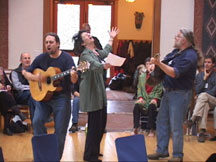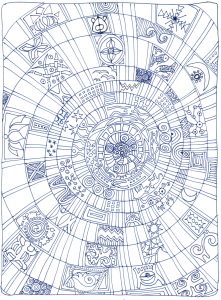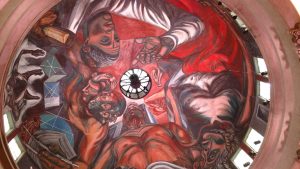 Knowledge, its creation, evolution and application, is rooted in social practice as described in social learning theory. In education, tradition may dictate the professor or the institution as the source of knowledge and the learners as recipients. Practice and application may come after the course is over, out of sight of the institutional in time and place. For some topics this can limit sense making and stunt the application and evolution of knowledge in the field. We need to build these sense making and application muscles while still in the classroom. My experience in the UdG Agora project and elsewhere shows me that Liberating Structures can support this muscle building.
Knowledge, its creation, evolution and application, is rooted in social practice as described in social learning theory. In education, tradition may dictate the professor or the institution as the source of knowledge and the learners as recipients. Practice and application may come after the course is over, out of sight of the institutional in time and place. For some topics this can limit sense making and stunt the application and evolution of knowledge in the field. We need to build these sense making and application muscles while still in the classroom. My experience in the UdG Agora project and elsewhere shows me that Liberating Structures can support this muscle building.
Tannis Morgan at the Justice Institute of British Columbia (JIBC) invited me to join her team designing and implementing the UdG Agora project they were developing with the University of Guadalajara in Mexico. Here is the brief description of the project:
The UdG Agora is a project of the University of Guadalajara (UdG) Student Centred and Mobile Learning Diploma. The goal of this faculty development program is for UdG professors to confidently integrate student centred and mobile learning strategies and activities in their courses.
Through the use of practical examples, challenges and experiential learning, the program will provide learners with the tools they need to meaningfully plan, design, implement and share student centred and mobile learning in their courses. Learners will collaborate, share, and contribute openly to a community of practice that fosters the enrichment of student centred learning experiences with the use of mobile learning technologies (iPads).
The program adopts the Agora as a metaphor for an open, collaborative, community space where learning happens through interaction and engagement with others. The Agora for this program are both face-to-face (f2f) and online spaces.
My role was to bring Liberating Structures as a learner engagement strategies along with some visual thinking/doing skills. Most of the team focused on the mobile learning elements.
Liberating Structures in Teaching and Learning
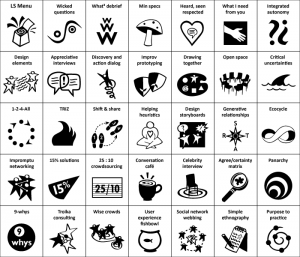 I was introduced to Liberating Structures some 6 years ago. As a process geek, my first glance led me to conclude that co-founders Keith McCandless and Henri Lipmanowicz had elicited a template and set of principles around a group of fairly familiar group processes. My first thought was “yeah, this is a really useful way of packaging some existing knowledge and practices.” Liberating Structures, at their simplest, are handy, useful practices. Anyone can pick a structure up and begin to apply it. Their primary strength is getting everyone unleashed and engaged in the group’s purpose which well aligns with my values. The key insight that I gained in this first exposure was the value and power of working with the duality of freedom and responsibility. Power is distributed with just enough constraints and pow, the action happens.
I was introduced to Liberating Structures some 6 years ago. As a process geek, my first glance led me to conclude that co-founders Keith McCandless and Henri Lipmanowicz had elicited a template and set of principles around a group of fairly familiar group processes. My first thought was “yeah, this is a really useful way of packaging some existing knowledge and practices.” Liberating Structures, at their simplest, are handy, useful practices. Anyone can pick a structure up and begin to apply it. Their primary strength is getting everyone unleashed and engaged in the group’s purpose which well aligns with my values. The key insight that I gained in this first exposure was the value and power of working with the duality of freedom and responsibility. Power is distributed with just enough constraints and pow, the action happens.
But there is more to Liberating Structures than a set of well described practices. There is the microstructure described through the design elements of invitation, distribution of participation, configuration of groups, arrangement of space, and the sequencing and allocation of time. It is a bit of a pattern language. This makes it easy to learn, select, sequence or “string” them together for different purposes. This is the “second level” of value of Liberating Structures. Once you know and are comfortable with a subset of structures, you can quickly plan, and adaptively apply LS to the work at hand. When you know the pattern of a microstructure, you can pay attention to things that support or block inclusion, such as the distribution of power which is otherwise left implicit or ignored. There is speed and flexibility, freedom and sufficient control/constraints. The rapid cycling through different thinking and doing modes unleashes people and helps them step out of their ruts.
But there is more to Liberating Structures than practices and (micro)structure. There are the 10 principles. This is where both the real disconnect and potential of of social learning in higher education shows up for me. Recently, LS practitioner Astrid Pruitt wrote about LS in higher education and noted that three of the 10 principles have a particular importance to her. I found her experiences resonant to mine. (Read her whole story – there are some great practical insights!)
Here is a quote from Astrid that is worth quoting in whole. I’ve added a few thoughts in parentheses.
“Now, when I look at these (her educational) experiences and use my LS lenses to discern them, it becomes clear to me that my conventional educational experiences violated three vital LS principles. They did not:
Practice Deep Respect for People and Local Solutions There was one expert whose knowledge and solutions were valued above all others. The collective experience of the class was ignored. (This is particularly true when we are looking to transfer knowledge, skills and approaches in fields such as international development where the imposition of the “academic” or “Northern” perspectives can foil even the best researched and documented interventions by assuming the expert approach is right and therefore should be “owned and implemented” locally, with little local participation in the process.)
Amplify Freedom and Responsibility Invitations to students to shape aspects of how the subject would be explored were sparse and awarded to a select few. Progress was tracked intermittently and failures were kept private. (In the introduction of LS at UdG, if the professors had no freedom and responsibility, everything we did would dissipate after the project was over. Freedom to choose, adapt and responsibility for the results desired was critical.)
Practice Self-Discovery Within a Group Student relationships with the subject matter was directed by the teacher and diversity of perspectives controlled. Limited peer-to-peer learning. Conversations substituted with powerpoints.” (We worry often about “wheel reinvention,” but my experience has shown that when people discover and learn themselves, there is a greater likelihood for adoption and evolution of what was learned.)
Co-founder Lipmanowicz notes that all 10 principles are regularly violated in many classrooms creating an even more compelling case for LS in education.
But there is more to Liberating Structures than practices, (micro)structure and principles. This is where the the deeper and long lasting value proposition emerged for me as I practiced more and dug deeper into LS through LS practice groups and immersion workshops. Liberating Structures work across many context. The real sweet spot for me is that they create conditions that wonderfully support real work in complex contexts. Have you ever have a moment when you don’t know the answer? Didn’t know exactly WHAT to do, but knew SOMETHING must be done? When you are asked to do a strategic plan in uncertain times, and knew instinctively you could not fall back on practices that result in stilted and abandoned plans that were outdated upon publication? Are you are wanting to do more than deliver content in a classroom, and instead want to equip your learners to apply and expand their own knowledge, teaching and learning that will last far outside of the course, classroom or degree? Do you look for bridges between seemingly contradictory challenges? When you are trying to step out of the deep ruts we have gotten ourselves into? LS are brilliant as we push new boundaries and have to sense, probe and prototype our way into the next steps. They don’t assume a single possibility, and help us see what we are trying to discern to move forward.
There is a reason for this brilliance that amplifies on first two strengths of practices and structure. It is the powerful combination of just enough structure and just enough freedom that allows us to work and push at boundaries of complex, complicated and even chaotic work. (CITATION) McCandless often pointed this out as the wonderful space like this:
Liberating [verb]: to set free from imposed, controlling structures
Structures [noun]: simple rules that specify how people are included and participate
LS gives us a way to describe, probe and challenge our assumptions, our patterns and even ourselves. This is essential in complex and emergent work. It supports what many of my colleagues have called for years “creative abrasion,” which helps us see and jump out of our ruts, to evolve thinking and practice in real time. For most work in higher education, both the domains and the application are in complex contexts, making LS in higher education a “muscle” for sense making and application.
Liberating Structures at the UdG Agora
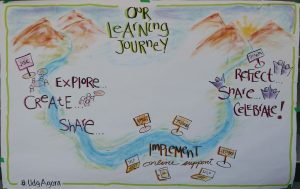 The Agora project kicked off with a 5 day face to face event on campus (3 days in the second iteration), followed by a 4 month planning and application phase where professors had to apply what they learned in three experiments or “challenges.” This was capped off with a final face to face reflection event on campus in the 6th month. You can read more about the Agora here, and here, and here. The initial F2F was framed around a series of mandatory and elective 75-90 minute hands-on studios bracketed with plenaries to introduce, socialize and make sense of the whole.
The Agora project kicked off with a 5 day face to face event on campus (3 days in the second iteration), followed by a 4 month planning and application phase where professors had to apply what they learned in three experiments or “challenges.” This was capped off with a final face to face reflection event on campus in the 6th month. You can read more about the Agora here, and here, and here. The initial F2F was framed around a series of mandatory and elective 75-90 minute hands-on studios bracketed with plenaries to introduce, socialize and make sense of the whole.
LS in plenaries
 Initially Liberating Structures were simply going to be the focus of one of the elective studios. As we began to design the agenda, we realized we could use LS throughout the days to “walk our talk” of learner engagement and steer clear of simple content dissemination. These professors knew their domains and generally experienced teachers, so we were not so much teaching, but irresistibly inviting them into a new way of engaging with us and their students. So not only were they exposed to a focused session on LS, they were experiencing and practicing throughout our time together.
Initially Liberating Structures were simply going to be the focus of one of the elective studios. As we began to design the agenda, we realized we could use LS throughout the days to “walk our talk” of learner engagement and steer clear of simple content dissemination. These professors knew their domains and generally experienced teachers, so we were not so much teaching, but irresistibly inviting them into a new way of engaging with us and their students. So not only were they exposed to a focused session on LS, they were experiencing and practicing throughout our time together.
In the plenaries, instead of starting with a lectures, we used Impromptu Networking to jumpstart relationships between professors, since phase two would require both triad groups (Troika Consulting) and larger communities of interest to support the project work. In the very first plenary, LS facilitated an “each one teach one” approach to immediately begin learning iPad skills, even with people who had not even opened the box yet. This is often referred to as “learn, pair, share” in education circles.
From the start, knowledge in the room was made visible and accessible.We frequently deployed 1-2-4-All to check understanding and sensemaking, both because the topics were new, but we were also working across two languages (Spanish and English). When debriefing, identifying and sharing learning, we used Users Experience Fishbowls, Shift and Share and Conversation Cafe.
Liberating Structures helped us get creative when conditions changed. When we had a large, open meeting space, we used only chairs, not tables, allowing us to quickly reconfigure group sizes. People did not end up sitting next to the same person all day, and bonds were created that lasted through the 6 month project. When our event was interrupted by an earthquake (yes, which eventually called for ending the day early as the campus closed), we could redesign and quickly recover. Sometimes we were packed into crowded lecture halls and 1-2-4-All facilitated social interaction, even in packed lecture halls when we could not get a big, open space. Engagement was high, naps were rare!
The Liberating Structures studio
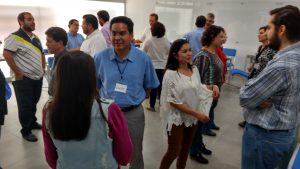 The LS studio started with Mad Tea to surface interests, possibilities and fears, introduced LS with a brief 10 minute presentation. Then professors selected from a range of “challenges” to practice and debrief one LS. The challenges offered three levels of difficulty and could be completed and debriefed during the studio.
The LS studio started with Mad Tea to surface interests, possibilities and fears, introduced LS with a brief 10 minute presentation. Then professors selected from a range of “challenges” to practice and debrief one LS. The challenges offered three levels of difficulty and could be completed and debriefed during the studio.
At the end of the studio we used What, So What, Now What to reflect on what  was happening in the studio, and to dive into how we support learners’ observational and critical thinking skills on a day to day basis, and 1-2-4-All to brainstorm how LS might be applied in each of their classrooms. In 90 minutes they used at least three structures as a whole group and one they designed and led or actively participated in themselves. This was capped with draft designs for classroom deployment, should they choose to do a LS challenge implementation. Interestingly, some of the other members of our team started using LS in their own studios!
was happening in the studio, and to dive into how we support learners’ observational and critical thinking skills on a day to day basis, and 1-2-4-All to brainstorm how LS might be applied in each of their classrooms. In 90 minutes they used at least three structures as a whole group and one they designed and led or actively participated in themselves. This was capped with draft designs for classroom deployment, should they choose to do a LS challenge implementation. Interestingly, some of the other members of our team started using LS in their own studios!
Application in the classroom and final debrief
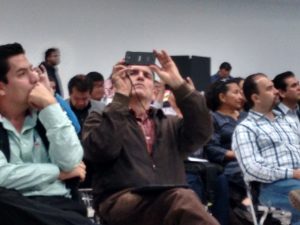 During the 4 month implementation phase professors worked in their own institutions and courses. One of their options was to apply LS in their classrooms alone, or with any of the other mobile and engaged learning strategies they learned in the phase 1 studios. Periodically through the second phase we held online meetings where people could share what they were doing, ask questions and generally support each other.
During the 4 month implementation phase professors worked in their own institutions and courses. One of their options was to apply LS in their classrooms alone, or with any of the other mobile and engaged learning strategies they learned in the phase 1 studios. Periodically through the second phase we held online meetings where people could share what they were doing, ask questions and generally support each other.
When we reconvened face to face to debrief and share lessons learned, we again used Liberating Structures as we did in the first face to face. By now, the professors were expecting this, not surprised. Engagement was deep, friendly and fun. Yes, fun!
Lessons Learned from LS at the UdG Agora
Liberating Structures was not a central element to supporting student engagement through mobile learning strategies. It was an elective, not a core studio. But it began to permeate the project leading to some initial lessons.
LS is easy to learn and do
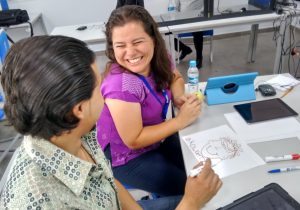 Even in a super short period of time, and as one tiny slice of an incredibly busy week, the professors were open to consider and incorporate LS into their practice. There was fast uptake of the LS basics. We used the microstructures to debrief, so the deeper LS literacy and the idea of stringing was planted right from the start. Few professors expressed concern that the LS gave too much control and power to the students and they clung to their “sage on the stage” stances. That said, when choosing which of the new things they learned to implement in their classrooms, many of them very fun and interactive mobile technologies, my sense was that it was the professors who were most engaged in improving how they taught who were the ones attracted to using LS for their implementation challenge.
Even in a super short period of time, and as one tiny slice of an incredibly busy week, the professors were open to consider and incorporate LS into their practice. There was fast uptake of the LS basics. We used the microstructures to debrief, so the deeper LS literacy and the idea of stringing was planted right from the start. Few professors expressed concern that the LS gave too much control and power to the students and they clung to their “sage on the stage” stances. That said, when choosing which of the new things they learned to implement in their classrooms, many of them very fun and interactive mobile technologies, my sense was that it was the professors who were most engaged in improving how they taught who were the ones attracted to using LS for their implementation challenge.
When we went online during the implementation phase, we focused on LS for one of our weekly live hangout online meetings and some enthusiastic participants shared their LS stories. Because the structures are well documented and described (and, thanks to one of our participants, many translated into Spanish!) the professors did not appear to fear “looking stupid” in trying them. Interestingly, some of their students were initially skeptical of this “new” approach of their professors.
One of the hallmarks of LS is that as a new practitioner you can use one and get pretty good results on the first try. What is remarkable is that as you gain deeper mastery, you get even better results! It would be very interesting to go back 12, 18 and 24 months to see how much LS has permeated their teaching. We know that some are still using it as they report via Twitter with the hashtag #UdGAgora and #liberatingstructures.
LS Supports both the domain and relational aspects of learning
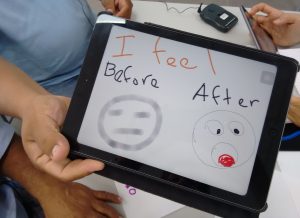 The UdG Agora project was focused on increasing student engagement through mobile learning and engaged teaching practices. Engagement does not sit just with the learner, but also with the professor. LS moves the power from “teacher as expert, student as learner” to a field where all are learning, and domain expertise is supported by the teacher. This is a result of “engaging and unleashing” everyone – not just the learners. And through this, teachers and students engage in a reciprocal learning relationship. Engaged professors seem to light up their students and vica versa.
The UdG Agora project was focused on increasing student engagement through mobile learning and engaged teaching practices. Engagement does not sit just with the learner, but also with the professor. LS moves the power from “teacher as expert, student as learner” to a field where all are learning, and domain expertise is supported by the teacher. This is a result of “engaging and unleashing” everyone – not just the learners. And through this, teachers and students engage in a reciprocal learning relationship. Engaged professors seem to light up their students and vica versa.
Another aspect I’ve been thinking about in terms of learning and applying LS is the data emerging from neurobiology related to “brain based” approaches. Dan Siegel writes how neurobiology might inform our teaching practices.He talks about the unity of the “triume brain” of cerebral cortex (rational brain), the limbic system (emotional brain) and the stem (reptilian brain). Siegel “envisions the brain as a social organ,” and “the emotional system that develops in relationship.” One of the consistent threads across all the UdG Agora studios and experiences was engagement between professors and students and between students.This highlights the social and relational aspects of learning and doing.
Siegel describes a “sixth sense” as “mindsight,” and links this to mirror neurons. He suggests that “What fires together, wires together,” is how we learn by what we observe. If we observer our teachers functioning as learners, will we be better learners? If we work to expand practice in the field, will it work better if we can operate from the mindset of a practitioner, not just an expert? If we can try out our ideas in a place of constructive support, can we begin to solve the tough challenges?. My Liberating Structures experiences at UdG and elsewhere suggests the answer is YES, particularly when we not only talk about something, but we model and practice it – even if the conditions are not exactly like the conditions the professors face in their classrooms. Siegel talks about the power of associations that people make in order to make sense of the world. Positive and uplifting associations can be more meaningful, encouraging, and benefit change. LS gives us those experiences quickly and simply. For some related reflections, see http://fullcirc.com/wp/2015/11/27/relationship-centric-teaching-part-3-of-iss-fellowship/
LS can support and strengthen existing pedagogies
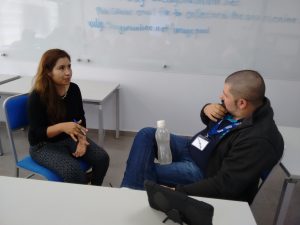 The University of Guadalajara is a huge university (100,000+ enrollment) with an immense public education mandate. There are many vestiges of formal lecture based approaches in some of the programs and professors are hired and rewarded for their subject matter expertise. Many are not deeply versed in pedagogical approaches and options. There is pressure to serve many students and our sense was that professors are stretched thin. Thus ALL the studios we offered on student engagement and mobile learning had to work with the existing classroom and program contexts. So before leaving a studio, we always asked for specific examples of how they could apply what they learned in the studio in their classroom. In the LS studio, professors could immediately identify specific opportunities that fit with their subject matter and pedagogical approaches. From the person who was primary a lecturer, to the hands-on professor – there were plenty of real, actionable applications. The early ideas focused on beginning of term activities to create and support relationships between students and between students and professors. This gives everyone a “toehold” regardless of where they are starting.
The University of Guadalajara is a huge university (100,000+ enrollment) with an immense public education mandate. There are many vestiges of formal lecture based approaches in some of the programs and professors are hired and rewarded for their subject matter expertise. Many are not deeply versed in pedagogical approaches and options. There is pressure to serve many students and our sense was that professors are stretched thin. Thus ALL the studios we offered on student engagement and mobile learning had to work with the existing classroom and program contexts. So before leaving a studio, we always asked for specific examples of how they could apply what they learned in the studio in their classroom. In the LS studio, professors could immediately identify specific opportunities that fit with their subject matter and pedagogical approaches. From the person who was primary a lecturer, to the hands-on professor – there were plenty of real, actionable applications. The early ideas focused on beginning of term activities to create and support relationships between students and between students and professors. This gives everyone a “toehold” regardless of where they are starting.
LS supports student achievement
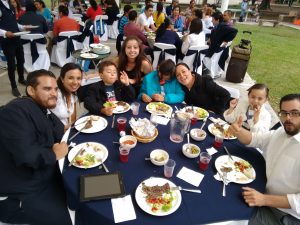 The value became visible in the third phase as we reconvened to share what was learned. I remember the words of a professor of dental hygiene who talked about how she totally restructured her introductory course, which had a history of a very high drop out rate and in this first implementation, so obliterated the dropout rate. I heard stories of very light incorporation of LS in the opening weeks of the semester, and how it changed the social-relational dynamics of their classrooms. I heard stories of twists and innovations on the LS they chose to use, and what the professors were learning about their own practice by switching it up, and challenging themselves. And the words that came in the feedback conversations were words like “engaged,” “alive” and even when some students initially resisted or were skeptical, they too were unleashed and liberated. When compared to feedback in other contexts, such as global meetings and team work, the responses are very resonant.
The value became visible in the third phase as we reconvened to share what was learned. I remember the words of a professor of dental hygiene who talked about how she totally restructured her introductory course, which had a history of a very high drop out rate and in this first implementation, so obliterated the dropout rate. I heard stories of very light incorporation of LS in the opening weeks of the semester, and how it changed the social-relational dynamics of their classrooms. I heard stories of twists and innovations on the LS they chose to use, and what the professors were learning about their own practice by switching it up, and challenging themselves. And the words that came in the feedback conversations were words like “engaged,” “alive” and even when some students initially resisted or were skeptical, they too were unleashed and liberated. When compared to feedback in other contexts, such as global meetings and team work, the responses are very resonant.
Application Beyond the Classroom and Moment
Liberating Structures is a wonderful set of tools to use in the classroom, training space and in meetings. But the lasting value is how it changes us and our practices once we leave these formalized spaces and moments. As we revisit the brain science insight about mirror neurons, we can again reflect on how the patterns that allow us to unleash and engage ourselves in a meeting can be carried out into the world. With the brain as “the emotional system that develops in relationship,” we recognize how the LS principles support that development through things such as Practice Deep Respect for People and Local Solutions, Amplify Freedom and Responsibility and Practice Self-Discovery Within a Group. As we practice, we become. As we become, we must practice the respect and amplification of freedom and responsibility.
There is a community of practice in the larger LS community about how to spread LS in the world. It is a true CoP in every sense of the word as we improvise, test, rethink, re-practice into ways to spread LS. While we try to reflect and debrief in our work across contexts, we probably could do a bit more – and more sharing of what we learn. But it is clear:
- Talking about LS is not enough.
- Demonstrating them in the abstract has value, but is not enough.
- Doing them, again and again, in similar and different strings and configurations, with riffs and variations, we build a literacy of engagement that helps us engage, work productively in complex contexts, have fun and DO GOOD!
References
UDG
LS in Higher Ed (sorry, I have not sorted these out yet – an ongoing project!)
LS in Other Contexts
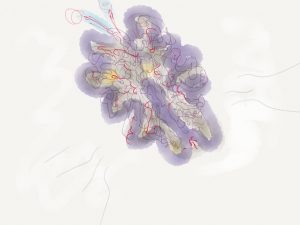 I snipped the quotes below from Chris Corrigan back in December (Some things that work in real reconciliation dialogue – Chris Corrigan ), meaning to write more about it. I think it is too important to wait for my “round to it” to happen, so here it is. Chris is writing about reconciliation. In our current political environment (especially here in the US) this is becoming a core competency, and can’t be left to luxury. The BOLDING is mine, with comments between points.
I snipped the quotes below from Chris Corrigan back in December (Some things that work in real reconciliation dialogue – Chris Corrigan ), meaning to write more about it. I think it is too important to wait for my “round to it” to happen, so here it is. Chris is writing about reconciliation. In our current political environment (especially here in the US) this is becoming a core competency, and can’t be left to luxury. The BOLDING is mine, with comments between points.
